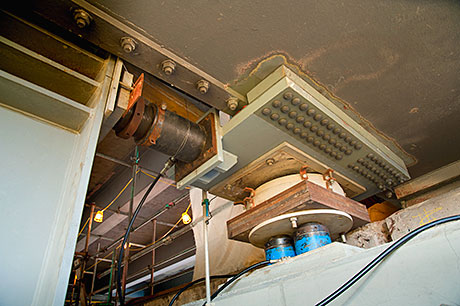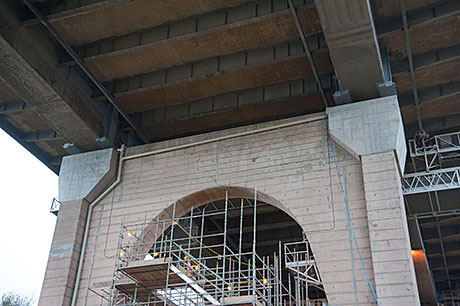
IN 2009, the Forth Estuary Transport Authority embarked on a competitive tender process for an estimated £15m package of works for the approach viaduct bridge bearing replacement and associated concrete repairs.
In early 2010 Freyssinet Makers, the northern structural repair division of Freyssinet, was appointed by Balfour Beatty Civil Engineering to assist with the refurbishment works on the north and south approach viaducts.
The work included the replacement of all the mechanical bridge bearings that support the bridge deck and enable it to move as required by changes in temperature. The contract also required an extensive overview of the concrete pier condition in conjunction with repair works and the installation of an impressed current cathodic protection system (ICCP).
It was the biggest single contract since the structure opened and was supervised by consulting engineer Atkins.


The bearing replacement works
Some 40 permanent mechanical bearings were specially designed to BS 5400 and manufactured in Freyssinet’s factory in Telford in quality-controlled conditions that exceed the requirements of BS EN ISO 9001 and parts of BS EN 1337. There were two types of bearing to be installed – fixed rocker and sliding guided – each weighing a massive 2500kg. These replaced the existing mechanical rocker and pin roller bearings that were badly worn and corroded.
In addition, the contract included the design and supply of 35 temporary support bearings and use of more than 100 hydraulic jacks to meet the requirements of the temporary support and restraint works. High-tensile Freyssibar was also supplied and stressed to assemble and fix the longitudinal restraint frames on to the structure.
Eight 32mm-diameter Freyssibars were supplied and installed, passing horizontally through the steel restraint bracket, newly-cast concrete corbel and the original pier head at over 3.5 metres long. End bearing plates, nuts and washers were then fixed to the end of each bar to secure the assembly in place. The bars were then stressed incrementally in an approved sequence to a final load of 505kN (50 tonnes) to provide the horizontal load restraint (via a tension clamping mechanism) in the temporary case. Upon completion of the jacking and bearing installation works the bars were de-tensioned in reverse sequence and removed for re-use at other jacking locations in the works.
Freyssinet was also responsible for all the hydraulic jacking and monitoring of the bridge deck to allow removal of the existing bridge bearings. The monitoring operation comprised a complex system of electronic sensors fixed to each pier location. Each sensor was wired to a data logger that captured all sensor data every two minutes; vertical/horizontal displacement, air temperature, pier verticality and pressures in the hydraulic support system. The system monitored the movement of the structure five days before the jacking operation, during the bridge bearing replacement and for 20 days after the new bearings were installed.
Bearing replacement work also considered the careful co-ordination of hydro-demolition works, steel cutting and drilling, and heavy lifting and positioning techniques to allow the careful and safe positioning of each bearing into an extremely restricted access gap.


The cathodic protection system
The ICCP system uses three anode systems: titanium mesh, titanium ribbon and discreet mixed metal oxide anodes. In addition, galvanic anodes were installed into repairs outside the impressed current zones.
Over 14km of titanium ribbon anode strip was installed into the concrete faces of the pier head cross beams and legs to form part of the CP system. Freyssinet introduced innovative techniques to cut chases into the concrete using a remotely operated wall saw; this improved productivity without exposing operatives to excessive hand-arm vibration or concrete dust.
Corrosion Control Services Ltd (CCSL), a subsidiary of Freyssinet, was involved in the procurement of specialist cathodic protection materials and supplied the specialist site supervision and technical commissioning required by the contract.
The Forth Road Bridge is an A-listed structure and consent had to be granted by Historic Scotland for the works to be carried out. Selection of all repair materials and methods of placement were carefully considered in technical trials prior to the start of the works in order to meet the requirements of the consent.
Images – The face of each pier was fitted with cathodic protection ribbons in chases. As the infrastructure begins to take shape nearby for its replacement, a major capital programme continues to strengthen the original Forth Road Bridge.











